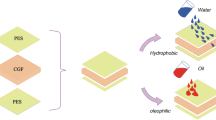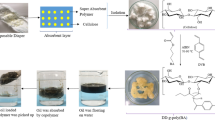Abstract
Luffa cylindrica is primarily used as a vegetable, but its dry fiber can be also used as a sponge. L. cylindrica has a ligneous fibrous netting system, in which the fibrous cords are disposed in a multidirectional array, forming a natural mat. In this work, we aim to synthesize a potential material for oil spill cleanup by the graft polymerization of butyl acrylate (BA) onto Luffa fiber (LF) using 2,2′-azobisisobutyronitrile (AIBN) as initiator. The grafting process has been controlled by monomer and AIBN concentrations, reaction time and temperature, in which the optimal condition for the highest graft yield of 40.60% is [AIBN] = 0.035 mol/L, [BA] = 1.50 mol/L, 180 min at 75 °C. The graft copolymer LF-g-BA is structurally characterized by the Fourier transform infrared spectroscopy, scanning electron microscopy and X-ray diffraction. In the presence of crosslinking agent divinyl benzene, the oil sorption capacity of the synthetic LF-g-BA reaches 20.60 g oil/g sorbent for 48-h treatment. The LF-g-BA material can be seen as a potential sorbent due to its swelling property in non/weak polar mediums and reusable feature.











Similar content being viewed by others
Data Availability
The data used to support the findings of this study are available from the corresponding author upon request.
References
Aidy A, Arifin F, Rassiah K, Othman F, Hazin MS, Megat Ahmad MMH (2018) Development and mechanical characterization of green bamboo composites. AIP Conf Proc 1930:020012. https://doi.org/10.1063/1.5022906
Daxiong W, Linlin F, Yanmin Q, Wenjuan W, Changming M, Haitao Z (2014) Oil sorbents with high sorption capacity, oil/water selectivity and reusability for oil spill cleanup. Mar Pollut Bull 84:263–267. https://doi.org/10.1016/j.marpolbul.2014.05.005
Deepak P, Arush S, Vandana S (2017b) Microwave induced graft copolymerization of binary monomers onto luffa cylindrica fiber: removal of congo red. Procedia Eng 200:408–415. https://doi.org/10.1016/j.proeng.2017.07.057
Deepak K, Jyoti P, Vinit R, Pramendra K (2017a) A review on the modification of polysaccharide through graft copolymerization for various potential applications. Open Med Chem J 11:109–126. https://doi.org/10.2174/1874104501711010109
Guillaume C, Hanno S, Susanne SR (2020) Origin and domestication of Cucurbitaceae crops: insights from phylogenies, genomics and archaeology. New Phyt 226:1240–1255. https://doi.org/10.1111/nph.16015
Hoang TH, Le TS, Nguyen Thi BV, Nguyen TD, Nguyen VK, Nguyen TT, Tran DM (2016) Oil sorbents based on methacrylic acid-grafted polypropylene fibers: Synthesis and characterization. J Chem Eng Process Technol 7:2. https://doi.org/10.4172/2157-7048.1000292
Ibrahim NA, Wan Yunus WMZ, Abu-IIaiwi FAF, Rahman MZA, Ahmad MB, Dahlan KZM (2003) Optimized condition for grafting reaction of poly(butyl acrylate) onto oil palm empty fruit bunch fibre. Polym Int 52:1119. https://doi.org/10.1002/pi.1192
Iman AEG, Fayza AES, Amer AERA, Mohamed H (2020) Oil spill sorption capacity of raw and thermally modifified orange peel waste. Alex Eng J 59:925–932. https://doi.org/10.1016/j.aej.2020.03.024
Jia L, Qian L, Yuan S, Qinyan Y, Baoyu G (2014) Characterization and swelling-deswelling properties of wheat straw cellulose based semi-IPNs hydrogel. Carbohydr Polym 107:232–240. https://doi.org/10.1016/j.carbpol.2014.02.073
Jigar MJ, Vijay KM (2007) Ceric ammonium nitrate induced grafting of polyacrylamide onto carboxymethyl chitosan. Carbohydr Polym 67:427–435. https://doi.org/10.1016/j.carbpol.2006.06.02
Jintao W, Yian Z, Yuru K, Aiqin W (2013) Investigation of oil sorption capability of PBMA/SiO2 coated kapok fiber. Chem Eng J 223(2013):632–637. https://doi.org/10.1016/j.cej.2013.03.007
Kangwansupamonkon W, Damronglerd S, Kiatkamjornwon S (2002) Effects of the crosslinking agent and diluents on bead properties of styrene-divinylbenzene copolymers. J Appl Polym Sci 85:654–669. https://doi.org/10.1002/app.10620
Khullar R, Varshney VK, Naithani S (2008) Grafting of acrylonitrile onto cellulosic material derived from bamboo (Dendrocalamus strictus). EXPRESS Polym Lett 2:12–18. https://doi.org/10.3144/expresspolymlett.2008.3
Miltiadis Z, Dimitrios T, Vassilios D, Theophilos I (2020) Application of sorbents for oil spill cleanup focusing on natural-based modified materials: a review. Molecules 25:4522. https://doi.org/10.3390/molecules25194522
Mohamad A, Babak S, Qasim Z, Mohammed A, Arameh E, Zhaoye Q (2020) Recent developments in Luffa natural fiber composites: review. Sustainability 12:7683. https://doi.org/10.3390/su12187683
Mohamed K, Thanaa AEM, Abdul-Raheim MAR, Khalid IK, Sabrnal HEH (2013) Synthesis and characterization of oil sorbent based hydroxypropyl cellulose acrylate. Egypt J Pet 22:539–548. https://doi.org/10.1016/j.ejpe.2013.11.008
Murat B, Olgun G (2009) A short review of radiation-induced raft-mediated graft copolymerization: a powerful combination for modifying the surface properties of polymers in a controlled manner. Radiat Phys Chem 78:1054–1059. https://doi.org/10.1016/j.radphyschem.2009.06.022
Qinhui C, Xinggong M, Hanyu X, Yi D, Jinhuo L (2013) Preparation and characterization of bamboo fiber-graft-lauryl methacrylate and its composites with polypropylene. J Appl Polym Sci 130:2377–2382. https://doi.org/10.1002/app.39347
Sabarinathan P, Rajkumar K, Gnanavelbabu A (2016) Mechanical properties of almond shell-sugarcane leaves hybrid epoxy polymer composite. Appl Mech Mater 852:43–48
Sadanand P, Shivani BM (2011) Graft copolymerization of ethylacrylate onto xanthan gum, using potassium peroxydisulfate as an initiator. Int J Biol Macromol 49:527–535. https://doi.org/10.1016/j.ijbiomac.2011.06.005
Sadanand P, Shivani BM (2013) Chromatographic resolution of racemic α-amino acids: chiral stationary phase derived from modified xanthan gum. Carbohydr Polym 92:2201–2205. https://doi.org/10.1016/j.carbpol.2012.11.102
Sadanand P, Jeong YD, Joonwoo K, Misook K (2020) Fast and highly efficient removal of dye from aqueous solution using natural locust bean gum based hydrogels as adsorbent. Int J Biol Macromol 143:60–75. https://doi.org/10.1016/j.ijbiomac.2019.12.002
Shouzheng S, Qi L, Jingyuan L, Hongsen Z, Rumin L, Xiaoyan J, Jun W (2018) Polyethyleneimine-functionalized Luffa cylindrica for efficient uranium extraction. J Colloid Interface Sci 530:538–546. https://doi.org/10.1016/j.jcis.2018.03.102
Teli MD, Sanket PV (2016) Grafting of butyl acrylate on to banana fibers for improved oil absorption. J Nat Fibers 13:470–476. https://doi.org/10.1080/15440478.2015.105503
Ting D, Guangbiao X, Fumei W (2015) Oil spill cleanup by structured natural sorbents made from cattail fibers. Ind Crops Prod 76:25–33. https://doi.org/10.1016/j.indcrop.2015.06.034
Veera MB, Sophie MU, Masahiko O, Kazuki S, Christopher M, Wayne Z, Thomas T (2016) Lipophilic super-absorbent swelling gels as cleaners for use on weapons systems and platforms, Final Report WP- 1761, U.S. Army Engineer Research and Development Center, Construction Engineering Research Laboratory
Vijay KT, Manju KT, Raju KG (2013) Development of functionalized cellulosic biopolymers by graft copolymerization. Int J Biol Macromol 62:44–51. https://doi.org/10.1016/j.ijbiomac.2013.08.026
Vijay KT, Manju KT, Raju KG (2014) Graft copolymers of natural fibers for green. Carbohydr Polym 104:87–93. https://doi.org/10.1016/j.carbpol.2014.01.016
Vinod KG, Deepak P, Shilpi A, Shikha S (2014) Amputation of congo red dye from waste water using microwave induced grafted Luffa cylindrica cellulosic fiber. Carbohydr Polym 111:556–566. https://doi.org/10.1016/j.carbpol.2014.04.032
Funding
The authors are grateful to Ministry of Industry and Trade (MOIT) via a project: ĐT.11.14/CNMT.
Author information
Authors and Affiliations
Contributions
Dr PTTH designated, Dr NTT and NTD performed experiments, and Dr NTS wrote manuscript.
Corresponding authors
Ethics declarations
Conflict of interest
The authors declare that they have no conflict of interest.
Ethical Approval
Our manuscript has not been submitted to more than one journal for simultaneous consideration. Our manuscript has not been published previously (partly or in full). A single study is not split up into several parts to increase the quantity of submissions and submitted to various journals or to one journal over time (e.g., “salami-publishing”). No data have been fabricated or manipulated (including images) to support your conclusions. No data, text, or theories by others are presented as if they were the author’s own (“plagiarism”). Proper acknowledgments to other works must be given (this includes material that is closely copied (near verbatim), summarized, and/or paraphrased), quotation marks are used for verbatim copying of material, and permissions are secured for material that is copyrighted.
Human and Animal Rights
Our current study did not involve human subject and has not used living animals, etc.
Rights and permissions
About this article
Cite this article
Tung, N.T., Duc, N.T., Ha, P.T.T. et al. Oil Sorbent Based on Luffa Fiber-Graft-Poly(Butyl Acrylate) Copolymer. Iran J Sci Technol Trans Sci 45, 1963–1970 (2021). https://doi.org/10.1007/s40995-021-01191-4
Received:
Accepted:
Published:
Issue Date:
DOI: https://doi.org/10.1007/s40995-021-01191-4




